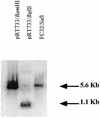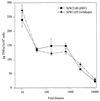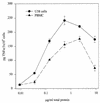Salmonella flagellin induces tumor necrosis factor alpha in a human promonocytic cell line
- PMID: 9488405
- PMCID: PMC108025
- DOI: 10.1128/IAI.66.3.1127-1134.1998
Salmonella flagellin induces tumor necrosis factor alpha in a human promonocytic cell line
Abstract
During infection of the gastrointestinal tract, salmonellae induce cytokine production and inflammatory responses which are believed to mediate tissue damage in the host. In a previous study, we reported that salmonellae possess the ability to stimulate tumor necrosis factor alpha (TNF-alpha) accumulation in primary human monocytes, as well as in the human promonocytic cell line U38. In this model system, cytokine upregulation is not due to lipopolysaccharide but is mediated by a released protein. In the present study, TnphoA transposon mutagenesis was used to identify the TNF-alpha-inducing factor. A mutant Salmonella strain which lacks the ability to induce TNF-alpha was isolated from a TnphoA library. Genetic analysis of this mutant demonstrated that the hns gene has been interrupted by transposon insertion. The hns gene product is a DNA-binding protein that regulates the expression of a variety of unrelated genes in salmonellae. One of the known targets of histone-like protein H1 is flhDC, the master operon which is absolutely required for flagellar expression. Analysis of other nonflagellated mutant Salmonella strains revealed a correlation between the ability to induce TNF-alpha and the expression of the phase 1 filament subunit protein FliC. Complementation experiments demonstrated that FliC is sufficient to restore the ability of nonflagellated mutant Salmonella strains to upregulate TNF-alpha, whereas the phase 2 protein FljB appears to complement to a lesser extent. In addition, Salmonella FliC can confer the TNF-alpha-inducing phenotype on Escherichia coli, which otherwise lacks the activity. Furthermore, assembly of FliC into complete flagellar structures may not be required for induction of TNF-alpha.
Figures



Similar articles
-
Salmonellae activate tumor necrosis factor alpha production in a human promonocytic cell line via a released polypeptide.Infect Immun. 1997 Nov;65(11):4624-33. doi: 10.1128/iai.65.11.4624-4633.1997. Infect Immun. 1997. PMID: 9353043 Free PMC article.
-
High-affinity interaction between gram-negative flagellin and a cell surface polypeptide results in human monocyte activation.Infect Immun. 2000 Oct;68(10):5525-9. doi: 10.1128/IAI.68.10.5525-5529.2000. Infect Immun. 2000. PMID: 10992449 Free PMC article.
-
Activation of interleukin-1 receptor-associated kinase by gram-negative flagellin.Infect Immun. 2001 Jul;69(7):4424-9. doi: 10.1128/IAI.69.7.4424-4429.2001. Infect Immun. 2001. PMID: 11401982 Free PMC article.
-
[Salmonella multiphasic flagellar antigen].Postepy Hig Med Dosw (Online). 2012 Jun 26;66:446-51. doi: 10.5604/17322693.1001631. Postepy Hig Med Dosw (Online). 2012. PMID: 22922144 Review. Polish.
-
Immune responses to epitopes inserted in Salmonella flagellin.Int Rev Immunol. 1994;11(2):167-78. doi: 10.3109/08830189409061724. Int Rev Immunol. 1994. PMID: 7519231 Review.
Cited by
-
Flagellin acting via TLR5 is the major activator of key signaling pathways leading to NF-kappa B and proinflammatory gene program activation in intestinal epithelial cells.BMC Microbiol. 2004 Aug 23;4:33. doi: 10.1186/1471-2180-4-33. BMC Microbiol. 2004. PMID: 15324458 Free PMC article.
-
Flagellin-Stimulated Production of Interferon-β Promotes Anti-Flagellin IgG2c and IgA Responses.Mol Cells. 2020 Mar 31;43(3):251-263. doi: 10.14348/molcells.2020.2300. Mol Cells. 2020. PMID: 32131150 Free PMC article.
-
Gene Expression Response of Salmonella enterica Serotype Enteritidis Phage Type 8 to Subinhibitory Concentrations of the Plant-Derived Compounds Trans-Cinnamaldehyde and Eugenol.Front Microbiol. 2017 Sep 26;8:1828. doi: 10.3389/fmicb.2017.01828. eCollection 2017. Front Microbiol. 2017. PMID: 29018419 Free PMC article.
-
Induction of cytokine synthesis by flagella from gram-negative bacteria may be dependent on the activation or differentiation state of human monocytes.Infect Immun. 1999 Oct;67(10):5176-85. doi: 10.1128/IAI.67.10.5176-5185.1999. Infect Immun. 1999. PMID: 10496893 Free PMC article.
-
Potential probiotic Lactiplantibacillus plantarum strains alleviate TNF-α by regulating ADAM17 protein and ameliorate gut integrity through tight junction protein expression in in vitro model.Cell Commun Signal. 2024 Oct 28;22(1):520. doi: 10.1186/s12964-024-01900-7. Cell Commun Signal. 2024. PMID: 39468700 Free PMC article.
References
-
- Ambler R P, Rees M W. ε-N-Methyl-lysine in bacterial flagellar protein. Nature (London) 1959;184:56–57. - PubMed
-
- Andreana A, Gollapudi S, Kim C H, Gupta S. Salmonella typhimurium activates human immunodeficiency virus type 1 in chronically infected promonocytic cells by inducing tumor necrosis factor-α production. Biochem Biophys Res Commun. 1994;201:16–23. - PubMed
-
- Arnold J W, Klimpel G R, Niesel D W. Tumor necrosis factor alpha (TNFα) regulates intestinal mucus production during salmonellosis. Cell Immunol. 1993;151:336–344. - PubMed
-
- Arnold J W, Niesel D W, Annable C R, Hess C B, Asuncion M, Cho Y J, Peterson J W, Klimpel G R. Tumor necrosis factor-α mediates the early pathology in Salmonella infection of the gastrointestinal tract. Microb Pathog. 1993;14:217–227. - PubMed
-
- Atlung T, Ingmer H. H-NS: a modulator of environmentally regulated gene expression. Mol Microbiol. 1997;24:7–17. - PubMed
Publication types
MeSH terms
Substances
Grants and funding
LinkOut - more resources
Full Text Sources
Other Literature Sources

